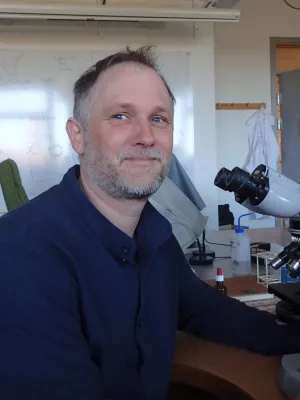
Karl Ljung
Lecturer

A Phenomenographic Analysis Of Students’ Experience Of Geological Time
Author
Summary, in English
Geological time is by many geoscience instructors considered a threshold concept for geoscience students, being a
central concept for how we experience geosceince phenomena that takes place on a spatio-temporal scale ranging
from micro (e.g. cloud formation) to macro (e.g. plate tectonics). If one wishes to understand geoscience phenomena
that goes beyond human perception, one must move from the concrete toward the abstract—from experiencing a
phenomenon with one’s senses toward an experience of the phenomenon that is based on an mind construct; we refer
to such competency as disciplinary spatio-temporal competency (DSTC). The purpose of this study is to gain an
understanding of how first-year students in a geoscience program in Sweden experience and represent the
phenomenon of geological time, i.e. to capture their DSTC. Analyazing data from three semi-structured group
interviews using a phenomenographic approach revealed how the students express geological time through their
language, their gestures, and their visualizations. From the result in this study, including four qualitatively different
themes, or categories of description, it is possible to conclude that the students' way of expressing geological time
give rise to exciting interpretations and we believe that these expressions can provide information also about how
students experience (and learn about) geological time. We report that through students’ illustrations and discussions,
students experience geological time as something more than a static one-dimensional straight line. The data analysis
shows that students connect geological time with spatio-temporal aspects from various geosientific phenomena, one
example of such an dynamic description of geological time is “One simply fills it with more information” indicating
that the students experience geological time as two-dimensional (space and time).
central concept for how we experience geosceince phenomena that takes place on a spatio-temporal scale ranging
from micro (e.g. cloud formation) to macro (e.g. plate tectonics). If one wishes to understand geoscience phenomena
that goes beyond human perception, one must move from the concrete toward the abstract—from experiencing a
phenomenon with one’s senses toward an experience of the phenomenon that is based on an mind construct; we refer
to such competency as disciplinary spatio-temporal competency (DSTC). The purpose of this study is to gain an
understanding of how first-year students in a geoscience program in Sweden experience and represent the
phenomenon of geological time, i.e. to capture their DSTC. Analyazing data from three semi-structured group
interviews using a phenomenographic approach revealed how the students express geological time through their
language, their gestures, and their visualizations. From the result in this study, including four qualitatively different
themes, or categories of description, it is possible to conclude that the students' way of expressing geological time
give rise to exciting interpretations and we believe that these expressions can provide information also about how
students experience (and learn about) geological time. We report that through students’ illustrations and discussions,
students experience geological time as something more than a static one-dimensional straight line. The data analysis
shows that students connect geological time with spatio-temporal aspects from various geosientific phenomena, one
example of such an dynamic description of geological time is “One simply fills it with more information” indicating
that the students experience geological time as two-dimensional (space and time).
Department/s
- Educational Sciences
- National Resource Centre for Physics Education
- Environmental Science
- Quaternary Sciences
- BECC: Biodiversity and Ecosystem services in a Changing Climate
- Department of Educational Sciences
Publishing year
2021
Language
English
Pages
1-26
Publication/Series
Journal of Astronomy & Earth Sciences Education (JAESE)
Volume
8
Issue
1
Document type
Journal article
Publisher
Clute Institute for Academic Research
Topic
- Geosciences, Multidisciplinary
- Pedagogy
Keywords
- Discipline-Based Education Research,
- Multimodality
- Phenomenography
- Spatio- Temporal Scales
- Geological Time
- DisciplGeoscience Education Research
Status
Published
ISBN/ISSN/Other
- ISSN: 2374-6254

